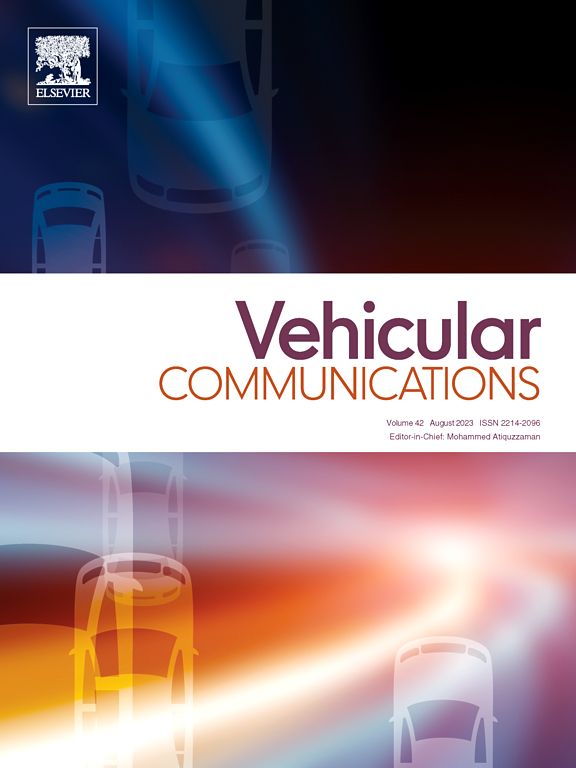Hybrid RF/VLC intelligent vehicular communications: A secrecy analysis
IF 6.5
2区 计算机科学
Q1 TELECOMMUNICATIONS
引用次数: 0
Abstract
Next generation intelligent transportation systems (ITS) are expected to use visible light communications (VLC) as a complementary technology to the existing radio frequency (RF)-based technologies in vehicle-to-everything (V2X) communication to provide secure and reliable transmission by exploiting the directivity and impermeability of light. Moreover, reconfigurable intelligent surfaces (RIS) are a promising solution to enhance the coverage and reliability of vehicle-to-vehicle (V2V) and vehicle-to-infrastructure (V2I) communications by modifying the phase, amplitude and polarization of incoming electromagnetic waves. Most previous works assumed double Rayleigh and Rayleigh fading channels for the RF links, with RIS-assisted setup lacking direct links between vehicles, and non-random distributions for vehicle movement in the VLC links. In this paper, we analyze the physical layer security performance of RIS-assisted hybrid RF/VLC links for both V2V and V2I scenarios. We also assume a direct line-of-sight (LoS) link between legitimate vehicles. In the existence of co-channel interference (CCI), an eavesdropper attempts to receive the information. We employ an accurate method to derive an exact expression for the cumulative distribution function (CDF) of RIS-assisted links combined with a direct link. More specifically, we derive closed-form expressions of secrecy outage probability (SOP), average secrecy capacity (ASC), probability of strictly positive secrecy capacity (PSPSC), effective secrecy throughput (EST), and intercept probability (IP). We assume double Nakagami-m fading for the V2V links, Nakagami-m channel for the V2I links, and log-Normal fading and uniform distribution for both longitude separation of Tx and Tx-Rx distance, leading to random path-loss. The correctness of the derivations is verified by using extensive Monte Carlo simulations for both V2V and V2I scenarios.
混合RF/VLC智能车载通信:保密性分析
下一代智能交通系统(ITS)预计将使用可见光通信(VLC)作为现有基于射频(RF)的车辆到一切(V2X)通信技术的补充技术,利用光的指向性和不渗透性提供安全可靠的传输。此外,可重构智能表面(RIS)是一种很有前途的解决方案,可以通过修改入射电磁波的相位、振幅和极化来增强车对车(V2V)和车对基础设施(V2I)通信的覆盖范围和可靠性。大多数先前的工作假设RF链路的双瑞利和瑞利衰落信道,ris辅助设置缺乏车辆之间的直接链接,并且VLC链路中车辆运动的非随机分布。在本文中,我们分析了V2V和V2I场景下ris辅助混合RF/VLC链路的物理层安全性能。我们还假设合法车辆之间有直接视距(LoS)连接。在共信道干扰(CCI)存在的情况下,窃听者试图接收信息。我们采用一种精确的方法推导出ris辅助链接与直接链接相结合的累积分布函数(CDF)的精确表达式。更具体地说,我们导出了保密中断概率(SOP)、平均保密容量(ASC)、严格正保密容量概率(PSPSC)、有效保密吞吐量(EST)和拦截概率(IP)的封闭表达式。我们假设V2V链路为双Nakagami-m衰落,V2I链路为Nakagami-m信道,Tx和Tx- rx距离的经度分离均为对数正态衰落和均匀分布,导致随机路径损失。通过对V2V和V2I场景进行广泛的蒙特卡罗模拟,验证了推导的正确性。
本文章由计算机程序翻译,如有差异,请以英文原文为准。
求助全文
约1分钟内获得全文
求助全文
来源期刊

Vehicular Communications
Engineering-Electrical and Electronic Engineering
CiteScore
12.70
自引率
10.40%
发文量
88
审稿时长
62 days
期刊介绍:
Vehicular communications is a growing area of communications between vehicles and including roadside communication infrastructure. Advances in wireless communications are making possible sharing of information through real time communications between vehicles and infrastructure. This has led to applications to increase safety of vehicles and communication between passengers and the Internet. Standardization efforts on vehicular communication are also underway to make vehicular transportation safer, greener and easier.
The aim of the journal is to publish high quality peer–reviewed papers in the area of vehicular communications. The scope encompasses all types of communications involving vehicles, including vehicle–to–vehicle and vehicle–to–infrastructure. The scope includes (but not limited to) the following topics related to vehicular communications:
Vehicle to vehicle and vehicle to infrastructure communications
Channel modelling, modulating and coding
Congestion Control and scalability issues
Protocol design, testing and verification
Routing in vehicular networks
Security issues and countermeasures
Deployment and field testing
Reducing energy consumption and enhancing safety of vehicles
Wireless in–car networks
Data collection and dissemination methods
Mobility and handover issues
Safety and driver assistance applications
UAV
Underwater communications
Autonomous cooperative driving
Social networks
Internet of vehicles
Standardization of protocols.
 求助内容:
求助内容: 应助结果提醒方式:
应助结果提醒方式:


